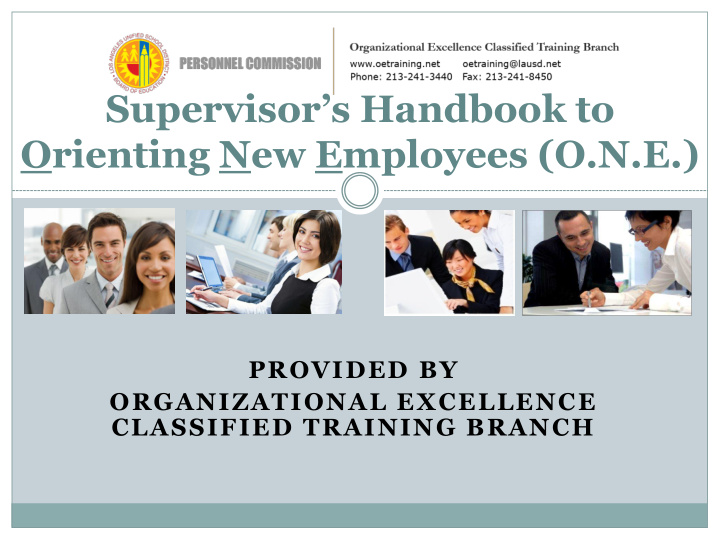



Supervisor’s Handbook to Orienting New Employees (O.N.E.) PROVIDED BY ORGANIZATIONAL EXCELLENCE CLASSIFIED TRAINING BRANCH
Why is Orienting Employees Important? Effective Orientations Help Employees To: Successfully adjust to a new job Understand roles and fit Shorten the learning curve Develop positive working relationships Reduce anxiety Create greater job satisfaction School/ LAUSD Community Employee Department
Supervisor’s Role in O.N.E. Make initial contact Clear your schedule Establish plans ahead of time for day 1 & beyond Lead by example Cultivate the “I can’t wait to get started” attitude Build trust
Why do Orientation Programs Fail? The Main Reasons Orientation Programs Fail: 1. Program was not planned. 2. Employee was not informed of the expectations. 3. Employee did not feel welcome. - Adapted from the International Personnel Management Assoc.
Before New Employee Begins Call employee to touch bases Mark your calendar Prepare workstation Notify and inform staff Setup buddy system Consider what training will be needed Enroll employee in New Employee Orientation Plan activities for first week and utilize his/her skills
Day One Show around facility Introduce to co-workers Complete essential paperwork Have lunch together Discuss most important policies and procedures Provide a checklist of topics to address Give copy of class description Create opportunities to practice
First Week Discuss: Important Procedures, Policies, Philosophies Class Description How Job Fits In and Impacts Others Performance Expectations Culture and Office Norms Upcoming Projects Interests and Goals Training Again, create opportunities to practice
Six Months Help Employee Gain Clarity, Reflect, Forge Ahead Clarify the employee’s role on an ongoing basis Communicate proper method for decision making Set check-in meetings periodically Reflect on work performance Clarify “permanent status” Forge ahead by encouraging employee to explore training opportunities
One Year Celebrate Accomplishments And Look to the Future Provide formal performance feedback Identify projects to gain skills Explore promotional opportunities Congratulate employee for not only getting the job but reaching this mark
Supervisor’s Role: Follow-up is Key Set the tone for future communication Regularly and consistently Evaluate – feedback goes both ways Complete performance evaluations during probation at: 2 months 4 months 6 months Permanent Status: 1 year
Where Do I Begin? Start by asking employees most recently hired about their experience...solicit feedback Prepare your list of goals for O.N.E. Develop a plan for accomplishing O.N.E. goals Inform current employees and be consistent Standardize and document process so it’s accessible for the next time around Refer to Orientation checklists and guidelines
Let’s Sum it Up! Begin in with th Basi sic c Job ob Survival vival Orientation Plan Buddy dy Syst stem em Begin in befo fore e day-one one Keep pla lan ongoing oing Do Inform form – Don’t Overwhelm Allow low time e for practic ctice e Provid vide e on the job b training ining
Recommend
More recommend